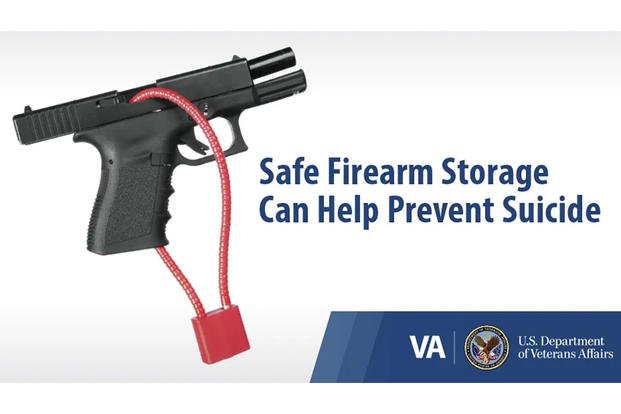The opinions expressed in this op-ed are those of the author and do not necessarily reflect the views of Military.com. If you would like to submit your own commentary, please send your article to opinions@military.com for consideration.
As gun ownership among women veterans has surged, so, too, have suicides where firearms are used.
In the recently released Department of Veterans Affairs' (VA) 2023 National Veteran Suicide Prevention Annual Report, between 2020 to 2021, the suicide rate among women veterans jumped 24.1% -- far greater than the 6.3% increase among male veterans. Firearms were used in 51.7% of women veterans' suicides, more often than all other methods combined. The rate of women veterans dying by firearm suicide was nearly three times higher than for non-veteran women.
These grim statistics should serve as a wake-up call for the need to pay close attention to the risk of firearm suicide for women veterans. This work requires a hard look at how ready access to firearms during dark moments correlates with deadly outcomes.
There are wide-ranging reasons why rates of firearm suicides for women veterans are rapidly rising. Gun ownership among women in general has doubled over the past 15 years. Half of women veterans either personally own a firearm or live in a household with one, far more than non-veteran women. Those firearms are stored unsafely approximately 43% of the time, more so among those with thoughts of suicide.
Pair that with the surge of firearm purchases at the onset of COVID-19, especially among women. During the pandemic, veterans in general reported increased social distress, with younger and women veterans demonstrating the greatest increases. Women veterans with histories of post-traumatic stress or military sexual assault -- both of which correlate with suicide attempts and suicide mortality -- reported higher levels of perceived pandemic-related threats and increased access to firearms.
The VA is responding to these trends with a multipronged approach. It has placed ad campaigns to reach all veterans, including those who have no contact with VA's health or benefits services. The programming, which has been viewed hundreds of millions of times, focuses on locking up one's firearms or temporarily transferring them to friends, family or storage facilities during crises.
Further, the VA's entire clinical workforce is now trained in safety counseling for at-risk veterans who value firearm ownership. That's been a crucial initiative, since surveys indicate that therapists are the most frequently cited resource that women veterans identify when asked whom they turn to when experiencing suicidal thoughts.
Both the Trump and Biden White Houses also joined this mission. At the start of the pandemic, the Trump administration issued a task force report of the President's Roadmap to Empower Veterans and End the National Tragedy of Suicide (PREVENTS). It emphasized that suicidal impulses often subside quickly, and that regardless of preexisting mental health conditions, voluntarily reducing one's access to firearms saves lives. The Biden administration amplified that strategy to encourage increased time and distance between suicidal thoughts and a trigger.
Yet, the dramatic increases highlighted in VA's annual report prove that much more is needed. The VA can't do this alone, and greater involvement from the firearm community will be essential.
In September, the VA joined with the National Shooting Sports Foundation and firearm trade advocates, manufacturers, retailers and range owners to advance joint efforts to promote secure firearm storage for suicide prevention. The industry's active engagement will be indispensable. Research confirms that messages advising citizens to store their firearms securely are accepted only when delivered by credible messengers through trusted channels. Specific attention to women veterans' reasons for gun ownership and storage practices must be tailored in this messaging. Women's gun organizations, such as A Girl & A Gun and Armed Women of America, are two natural avenues for reaching women.
Cable-style gun locks are currently provided gratis to any veteran who wants one, but surveys have determined that gun safes and lock boxes are preferred. A third of veterans who store their firearms loaded and unlocked don't own a lockbox or safe. A VA pilot program is offering these larger devices, cost free, to veterans who request them. Congress should make this program national, permanent and well-funded.
Studies show that suicidal patients have a four-fold reduction in attempts and/or death when care providers inquire about their access to firearms. This fact puts extra responsibility on the contracted pool of one million community providers and grantees who supplement VA's care. The annual report found that veterans treated by those providers were more likely to die by suicide than if care was furnished from the VA.
The VA's report concludes, "Veteran suicide rates will likely not significantly improve until there is increased collective engagement regarding the relationship between Veteran suicide and firearms." Indeed, it will take an all-of-nation effort -- firearm and veteran constituencies, along with the VA -- to protect the freedom to own firearms while also strengthening safe storage practices, especially during periods of crisis. That pathway forward will save lives.
Nancy G. Espinosa, a service-connected disabled veteran of the Army, Reserve and National Guard, was elected national commander for Disabled American Veterans in August 2023.
Russell B. Lemle, Ph.D., is senior policy analyst for the Veterans Healthcare Policy Institute. He's authored numerous scientific publications and media commentaries, and testified to Congress, on veterans' health care and the prevention of firearm suicide. From 1993 to 2019, he served as chief psychologist for the San Francisco VA Health Care System.











